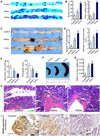Loss of abhd5 promotes colorectal tumor development and progression by inducing aerobic glycolysis and epithelial-mesenchymal transition
- PMID: 25482557
- PMCID: PMC4268306
- DOI: 10.1016/j.celrep.2014.11.016
Loss of abhd5 promotes colorectal tumor development and progression by inducing aerobic glycolysis and epithelial-mesenchymal transition
Erratum in
-
Loss of Abhd5 Promotes Colorectal Tumor Development and Progression by Inducing Aerobic Glycolysis and Epithelial-Mesenchymal Transition.Cell Rep. 2018 Sep 4;24(10):2795-2797. doi: 10.1016/j.celrep.2018.08.050. Cell Rep. 2018. PMID: 30184511 Free PMC article. No abstract available.
Abstract
How cancer cells shift metabolism to aerobic glycolysis is largely unknown. Here, we show that deficiency of α/β-hydrolase domain-containing 5 (Abhd5), an intracellular lipolytic activator that is also known as comparative gene identification 58 (CGI-58), promotes this metabolic shift and enhances malignancies of colorectal carcinomas (CRCs). Silencing of Abhd5 in normal fibroblasts induces malignant transformation. Intestine-specific knockout of Abhd5 in Apc(Min/+) mice robustly increases tumorigenesis and malignant transformation of adenomatous polyps. In colon cancer cells, Abhd5 deficiency induces epithelial-mesenchymal transition by suppressing the AMPKα-p53 pathway, which is attributable to increased aerobic glycolysis. In human CRCs, Abhd5 expression falls substantially and correlates negatively with malignant features. Our findings link Abhd5 to CRC pathogenesis and suggest that cancer cells develop aerobic glycolysis by suppressing Abhd5-mediated intracellular lipolysis.
Copyright © 2014 The Authors. Published by Elsevier Inc. All rights reserved.
Figures







Similar articles
-
Loss of ABHD5 promotes the aggressiveness of prostate cancer cells.Sci Rep. 2017 Oct 12;7(1):13021. doi: 10.1038/s41598-017-13398-w. Sci Rep. 2017. PMID: 29026202 Free PMC article.
-
ABHD5 inhibits YAP-induced c-Met overexpression and colon cancer cell stemness via suppressing YAP methylation.Nat Commun. 2021 Nov 18;12(1):6711. doi: 10.1038/s41467-021-26967-5. Nat Commun. 2021. PMID: 34795238 Free PMC article.
-
Macrophage ABHD5 promotes colorectal cancer growth by suppressing spermidine production by SRM.Nat Commun. 2016 May 18;7:11716. doi: 10.1038/ncomms11716. Nat Commun. 2016. PMID: 27189574 Free PMC article.
-
The important role of epidermal triacylglycerol metabolism for maintenance of the skin permeability barrier function.Biochim Biophys Acta. 2014 Mar;1841(3):409-15. doi: 10.1016/j.bbalip.2013.07.013. Epub 2013 Aug 6. Biochim Biophys Acta. 2014. PMID: 23928127 Review.
-
ABHD5 as a friend or an enemy in cancer biology?Front Oncol. 2024 Sep 12;14:1447509. doi: 10.3389/fonc.2024.1447509. eCollection 2024. Front Oncol. 2024. PMID: 39328203 Free PMC article. Review.
Cited by
-
CGI-58: Versatile Regulator of Intracellular Lipid Droplet Homeostasis.Adv Exp Med Biol. 2020;1276:197-222. doi: 10.1007/978-981-15-6082-8_13. Adv Exp Med Biol. 2020. PMID: 32705602 Free PMC article. Review.
-
The sweet trap in tumors: aerobic glycolysis and potential targets for therapy.Oncotarget. 2016 Jun 21;7(25):38908-38926. doi: 10.18632/oncotarget.7676. Oncotarget. 2016. PMID: 26918353 Free PMC article. Review.
-
Lipolysis in Brown Adipocytes Is Not Essential for Cold-Induced Thermogenesis in Mice.Cell Metab. 2017 Nov 7;26(5):764-777.e5. doi: 10.1016/j.cmet.2017.09.002. Epub 2017 Oct 5. Cell Metab. 2017. PMID: 28988822 Free PMC article.
-
Loss of adipose triglyceride lipase is associated with human cancer and induces mouse pulmonary neoplasia.Oncotarget. 2016 Jun 7;7(23):33832-40. doi: 10.18632/oncotarget.9418. Oncotarget. 2016. PMID: 27213586 Free PMC article.
-
Adipose triglyceride lipase activity regulates cancer cell proliferation via AMP-kinase and mTOR signaling.Biochim Biophys Acta Mol Cell Biol Lipids. 2020 Sep;1865(9):158737. doi: 10.1016/j.bbalip.2020.158737. Epub 2020 May 11. Biochim Biophys Acta Mol Cell Biol Lipids. 2020. PMID: 32404277 Free PMC article.
References
-
- Accioly MT, Pacheco P, Maya-Monteiro CM, Carrossini N, Robbs BK, Oliveira SS, Kaufmann C, Morgado-Diaz JA, Bozza PT, Viola JP. Lipid bodies are reservoirs of cyclooxygenase-2 and sites of prostaglandin-E2 synthesis in colon cancer cells. Cancer research. 2008;68:1732–1740. - PubMed
-
- Behrens J, Jerchow BA, Wurtele M, Grimm J, Asbrand C, Wirtz R, Kuhl M, Wedlich D, Birchmeier W. Functional interaction of an axin homolog, conductin, with beta-catenin, APC, and GSK3beta. Science. 1998;280:596–599. - PubMed
-
- Bozza PT, Viola JP. Lipid droplets in inflammation and cancer. Prostaglandins, leukotrienes, and essential fatty acids. 2010;82:243–250. - PubMed
-
- Brown JM, Chung S, Das A, Shelness GS, Rudel LL, Yu L. CGI-58 facilitates the mobilization of cytoplasmic triglyceride for lipoprotein secretion in hepatoma cells. Journal of lipid research. 2007;48:2295–2305. - PubMed
Publication types
MeSH terms
Substances
Grants and funding
LinkOut - more resources
Full Text Sources
Other Literature Sources
Medical
Molecular Biology Databases
Research Materials
Miscellaneous

